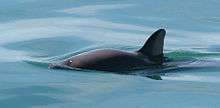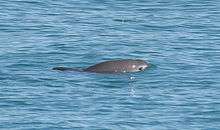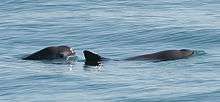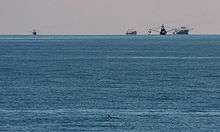Vaquita
The vaquita (Phocoena sinus), literally "little cow", is a species of porpoise endemic to the northern end of the Gulf of California (Sea of Cortez, Vermilion Sea). Averaging 150 cm (for females) or 140 cm (for males) in length, it is the smallest of all living cetaceans. Today, the species is on the brink of extinction. Recent research estimates the population at fewer than 19 individuals.[3] The steep decline in abundance is primarily due to bycatch in gillnets from the illegal totoaba fishery.[4][5]
| Vaquita | |
|---|---|
 | |
 | |
| Size compared to an average human | |
| Scientific classification | |
| Kingdom: | Animalia |
| Phylum: | Chordata |
| Class: | Mammalia |
| Order: | Artiodactyla |
| Infraorder: | Cetacea |
| Family: | Phocoenidae |
| Genus: | Phocoena |
| Species: | P. sinus |
| Binomial name | |
| Phocoena sinus Norris & McFarland, 1958 | |
| Vaquita range | |
Taxonomy
The vaquita was first described as a species by marine biologists Kenneth S. Norris and William N. McFarland in 1958 after studying the morphology of skull specimens found on the beach.[6] It was not until nearly thirty years later, in 1985, that fresh specimens allowed scientists to describe their external appearance fully.[7]
The genus Phocoena comprises four species of porpoise, most of which inhabit coastal waters (the spectacled porpoise is more oceanic). The vaquita is most closely related to Burmeister’s porpoise (Phocoena spinipinnis) and less so to the spectacled porpoise (Phocoena dioptrica), two species limited to the Southern Hemisphere. Their ancestors are thought to have moved north across the equator more than 2.5 million years ago during a period of cooling in the Pleistocene.[7] Genome sequencing from an individual captured in 2017 indicates that the ancestral vaquitas had already gone through a major population bottleneck in the past, which may explain why the few remaining individuals are still healthy despite the very low population size.[8]
Description

The smallest living species of cetacean, the vaquita can be easily distinguished from any other species in its range. It has a small body with an unusually tall, triangular dorsal fin, a rounded head, and no distinguished beak. The coloration is mostly grey with a darker back and a white ventral field. Prominent black patches surround its lips and eyes.[7] Sexual dimorphism is apparent in body size, with mature females being longer than males and having larger heads and wider flippers.[7][9] Females reach a maximum size of about 150 cm, while males reach about 140 cm.[7] Dorsal fin height is greater in males than in females.[9]
Distribution and habitat
Vaquita habitat is restricted to a small portion of the upper Gulf of California (also called the Sea of Cortez), making this the smallest range of any marine mammal species. They live in shallow, turbid waters of less than 50 m depth (150 ft).[5]
Diet
Vaquitas are generalists, foraging on a variety of demersal fish species, crustaceans, and squids, though benthic fish such as grunts and croakers make up most of the diet.[5]
Social behavior

Vaquitas are generally seen singly or in pairs, often with a calf, but have been observed in small groups of up to 10 individuals.[5]
Little is known about the life history of this species. Life expectancy is estimated at about 20 years and age of sexual maturity is somewhere between 3 and 6 years of age.[10] While an initial analysis of stranded vaquitas estimated a two-year calving interval, recent sightings data suggest that vaquitas can reproduce annually.[10][11] It is thought that vaquitas have a polygynous mating system in which males compete for females. This competition is evidenced by the presence of sexual dimorphism (females are larger than males), small group sizes, and large testes (accounting for nearly 3% of body mass).[10]
Population status
Because the vaquita was only fully described in the late 1980s, historical abundance is unknown.[12] The first comprehensive vaquita survey throughout their range took place in 1997 and estimated a population of 567 individuals.[13] By 2007 abundance was estimated to have dropped to 150.[14] Population abundance as of 2018 was estimated at less than 19 individuals.[3] Given the continued rate of bycatch and low reproductive output from a small population, it is possible that there are as few as 10 vaquitas alive today.[3][15][16]
Threats
Fisheries bycatch

The drastic decline in vaquita abundance is the result of fisheries bycatch in commercial and illegal gillnets, including fisheries targeting the now-endangered totoaba, shrimp, and other available fish species.[4][12] In spite of government regulations, including a partial gillnet ban in 2015 and establishment of a permanent gillnet exclusion zone in 2017, illegal fishing remains prevalent in vaquita habitat, and as a result the population has continued to decline.[3]
Other threats
Given their proximity to the coast, vaquitas are exposed to habitat alteration and pollution from runoff. There is no evidence, however, that these threats have made any significant contribution to their decline. Bycatch is the single biggest threat to the survival of the few remaining vaquita.[15]
Conservation status
The vaquita is listed as critically endangered on the IUCN Red List.[5] Today, this is the most endangered marine mammal in the world.[3][5]
The species is also protected under the US Endangered Species Act, the Mexican Official Standard NOM-059 (Norma Oficial Mexicana) , and Appendix II of the Convention on International Trade in Endangered Species of Wild Fauna and Flora (CITES).
Conservation efforts
The Mexican government, international committees, scientists, and conservation groups have recommended and implemented plans to help reduce the rate of bycatch, enforce gillnet bans, and promote population recovery.
Mexico launched a program in 2008 called PACE-VAQUITA in an effort to enforce the gillnet ban in the Biosphere Reserve, allow fishermen to swap their gillnets for vaquita-safe fishing gear, and provide economic support to fishermen for surrendering fishing permits and pursuing alternative livelihoods.[17] Despite the progress made with legal fishermen, hundreds of poachers continued to fish in the exclusion zone.
With continued illegal totoaba fishing and uncontrolled bycatch of vaquitas, the International Committee for the Recovery of the Vaquita (CIRVA) recommended that some vaquitas be removed from the high-density fishing area and be relocated to protected sea pens. This effort, called VaquitaCPR, captured two vaquitas in 2017: one was later released and the other died shortly after capture after both suffered from shock.[18]
Local and international conservation groups, including Museo de Ballena and Sea Shepherd Conservation Society, are working with the Mexican Navy to detect fishing in the Refuge Area and remove illegal gillnets.[17] In March 2020, the U.S. National Marine Fisheries Service (NMFS) announced a ban on imported Mexican shrimp and other seafood caught in vaquita habitat in the northern Gulf of California.[19]
To date, efforts have been unsuccessful in solving the complex socioeconomic and environmental issues that affect vaquita conservation and the greater Gulf of California ecosystem. Necessary action includes habitat protection, resource management, education, fisheries enforcement, alternative livelihoods for fishermen, and raising awareness of the vaquita and associated issues.[5]
References
- Fossilworks Database. "Fossilworks". Fossilworks Gateway to paleotology. John Alory. Retrieved 25 April 2018.
- Rojas-Bracho, L.; Taylor, B.L. (2017). "Phocoena sinus". IUCN Red List of Threatened Species. 2017: e.T17028A50370296. Retrieved 17 June 2020. (previous version)
- Jaramillo-Legorreta, Armando M.; Cardenas-Hinojosa, Gustavo; Nieto-Garcia, Edwyna; Rojas-Bracho, Lorenzo; Thomas, Len; Ver Hoef, Jay M.; Moore, Jeffrey; Taylor, Barbara; Barlow, Jay; Tregenza, Nicholas (2019). "Decline towards extinction of Mexico's vaquita porpoise (Phocoena sinus)". Royal Society Open Science. 6 (7): 190598. doi:10.1098/rsos.190598. PMC 6689580. PMID 31417757.
- Rojas-Bracho, Lorenzo; Reeves, Randall R. (3 July 2013). "Vaquitas and gillnets: Mexico's ultimate cetacean conservation challenge". Endangered Species Research. 21 (1): 77–87. doi:10.3354/esr00501. ISSN 1863-5407.
- Barbara Taylor (Protected Resources Division, Southwest Fisheries Science Center; Rojas-Bracho, Lorenzo (20 July 2017). "IUCN Red List of Threatened Species: Vaquita". IUCN Red List of Threatened Species. Retrieved 29 March 2020.
- Norris, Kenneth S.; McFarland, William N. (20 February 1958). "A New Harbor Porpoise of the Genus Phocoena from the Gulf of California". Journal of Mammalogy. 39 (1): 22–39. doi:10.2307/1376606. ISSN 0022-2372.
- Brownell, Robert L.; Findley, Lloyd T.; Vidal, Omar; Robles, Alejandro; Manzanilla, N. Silvia (1987). "External Morphology and Pigmentation of the Vaquita, Phocoena Sinus (cetacea: Mammalia)". Marine Mammal Science. 3 (1): 22–30. doi:10.1111/j.1748-7692.1987.tb00149.x. ISSN 1748-7692.
- Casanueva, Agustín B. Ávila (11 July 2020). "Secuenciar el genoma de la vaquita marina es la esperanza para su conservación". TecReview (in Spanish). Retrieved 14 July 2020.
- Torre, Jorge; Vidal, Omar; Brownell, Robert L. (October 2014). "Sexual dimorphism and developmental patterns in the external morphology of the vaquita, Phocoena sinus". Marine Mammal Science. 30 (4): 1285–1296. doi:10.1111/mms.12106.
- Hohn, A. A.; Read, A. J.; Fernandez, S.; Vidal, O.; Findley, L. T. (1996). "Life history of the vaquita, Phocoena sinus (Phocoenidae, Cetacea)". Journal of Zoology. 239 (2): 235–251. doi:10.1111/j.1469-7998.1996.tb05450.x. ISSN 1469-7998.
- Taylor, Barbara L.; Wells, Randall S.; Olson, Paula A.; Brownell, Robert L.; Gulland, Frances M. D.; Read, Andrew J.; Valverde‐Esparza, Francisco J.; Ortiz‐García, Oscar H.; Ruiz‐Sabio, Diego; Jaramillo‐Legorreta, Armando M.; Nieto‐Garcia, Edwyna (2019). "Likely annual calving in the vaquita, Phocoena sinus: A new hope?". Marine Mammal Science. 35 (4): 1603–1612. doi:10.1111/mms.12595. ISSN 1748-7692.
- Rojas‐Bracho, Lorenzo; Reeves, Randall R.; Jaramillo‐Legorreta, Armando (2006). "Conservation of the vaquita Phocoena sinus". Mammal Review. 36 (3): 179–216. doi:10.1111/j.1365-2907.2006.00088.x. ISSN 1365-2907.
- Jaramillo‐Legorreta, Armando M.; Rojas‐Bracho, Lorenzo; Gerrodette, Tim (1999). "A New Abundance Estimate for Vaquitas: First Step for Recovery1". Marine Mammal Science. 15 (4): 957–973. doi:10.1111/j.1748-7692.1999.tb00872.x. ISSN 1748-7692.
- Jaramillo-Legorreta, Armando; Rojas-Bracho, Lorenzo; Brownell, Robert L.; Read, Andrew J.; Reeves, Randall R.; Ralls, Katherine; Taylor, Barbara L. (15 November 2007). "Saving the Vaquita: Immediate Action, Not More Data". Conservation Biology. 21 (6): 071117012342001–???. doi:10.1111/j.1523-1739.2007.00825.x. ISSN 0888-8892. PMID 18173491.
- "Report of the Eleventh meeting of the Comité Internacional para la Recuperación de la Vaquita (CIRVA)" (PDF).
- "The Vaquita Porpoise: A Conservation Emergency". VIVA Vaquita.
- "Vaquita – IUCN – SSC Cetacean Specialist Group". Retrieved 29 March 2020.
- Rojas-Bracho, L; Gulland, FMD; Smith, CR; Taylor, B; Wells, RS; Thomas, PO; Bauer, B; Heide-Jørgensen, MP; Teilmann, J; Dietz, R; Balle, JD (11 January 2019). "A field effort to capture critically endangered vaquitas Phocoena sinus for protection from entanglement in illegal gillnets". Endangered Species Research. 38: 11–27. doi:10.3354/esr00931. ISSN 1863-5407.
- 4 March; 2020. "U.S. Government Expands Mexican Seafood Ban to Save Vaquita Porpoise". NRDC. Retrieved 24 April 2020.CS1 maint: numeric names: authors list (link)
Further reading
- Alcántara, A. (December 2017). "Vaquita: The Business of Extinction (article and 25-min. documentary video)". CNN. Retrieved 7 December 2017.
- Bessesen, Brooke (September 2018). Vaquita: Science, Politics, and Crime in the Sea of Cortez. Island Press. ISBN 978-1-61091-932-6.
- Vance, E. (August 2017). "Goodbye, Vaquita: How Corruption and Poverty Doom Endangered Species". Scientific American. 317 (2): 36–45. doi:10.1038/scientificamerican0817-36. PMID 29565922.
External links
| Wikimedia Commons has media related to Phocoena sinus. |
To learn more about the vaquita and conservation efforts visit:
- ¡Viva Vaquita! – a non-profit organization dedicated to preventing the extinction of the vaquita
- IUCN Red List
- Vaquita fact sheet from NOAA Fisheries
- The Vaquita and the Totoaba – web site for the Wild Lens Collective of film makers' outreach campaign about the vaquita's extinction crisis
- "Souls of the Vermilion Sea", a 30-minute documentary about the local community where the vaquita is found and why its population has declined
- "Sea of Shadows", a full-length 2019 documentary produced by Leonardo DiCaprio on the effort to rescue the vaquita from extinction
- Voices in the Sea – sounds of the vaquita
- VaquitaMarina.org, a Baja California Sur-based vaquita conservation group
- Operation Milagro III, Sea Shepherd Conservation Society's operation to protect the vaquita
- Porpoise Conservation Society
- Society for Marine Mammalogy
- Operation Fake Gold, [Earth League International]
